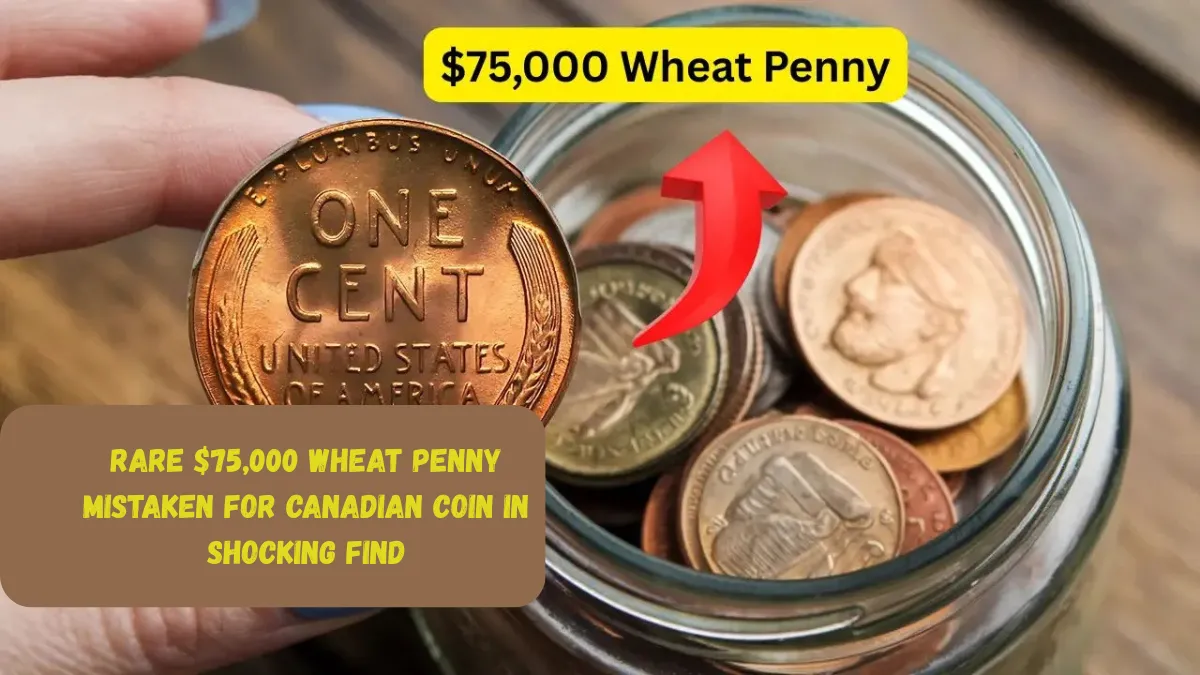She Thought It Was Canadian Coin
What began as a routine afternoon of sorting through loose change became a life-altering moment for a woman in Michigan. She had been casually sifting through an old jar of coins—something many people do without much thought—when a particular penny caught her attention. Its worn appearance and slightly different tone led her to assume it was a Canadian coin, perhaps brought back unknowingly from a trip or mixed in by mistake over the years.
However, when she examined it more closely, she noticed something that set it apart: the reverse side featured the classic wheat stalk design, indicating it was a U.S. penny. This tiny clue triggered her curiosity, and a simple internet search revealed that she might be holding a rare and valuable piece of American history—a 1944 steel wheat penny, an error coin worth as much as $75,000.
The Moment of Realization
The woman, who chose to remain anonymous, vividly described the moment she realized she might be onto something big. She said the coin looked darker and more worn than the others in her collection. Its unusual coloration made her think it might be a foreign coin, and she nearly tossed it aside. But something about its design made her pause. When she noticed the wheat stalks—used on pennies minted from 1909 to 1958—she took a closer look.
Her curiosity intensified as she realized the coin wasn’t made of copper like most 1944 pennies. After a bit of research and comparison with images online, the shocking possibility dawned on her. Her hands trembled as she considered what she might be holding. It was only after a visit to a professional coin dealer that her suspicions were confirmed: the coin was indeed one of the rare 1944 steel wheat pennies.
Why This Penny Is So Special
The 1944 steel wheat penny is considered one of the rarest and most desirable coins among U.S. collectors. In 1943, due to wartime demands, pennies were made of steel coated in zinc to save copper for military use. However, in 1944, the U.S. Mint returned to using copper for pennies. A few steel blanks from the previous year accidentally remained in the minting machines, resulting in a tiny number of 1944 steel pennies being produced by mistake.
These error coins were never meant to exist, and only an estimated 25–30 are known to be in circulation today. When authenticated in good condition, they command incredibly high prices at auctions and from private collectors. The Michigan woman’s coin was not only genuine but also in excellent shape, which dramatically boosted its appraisal value. Its rarity, historical context, and condition combined to make it a six-figure collectible.
A Spark of Curiosity Across the Country
News of this unexpected discovery spread quickly, igniting a surge of interest in coin collecting across the United States. People who had never thought twice about their spare change began reexamining their coin jars, piggy banks, and even the cushions of their couches, hoping to stumble upon their own hidden treasure. Experts in numismatics—the study and collection of coins—encourage the public to stay alert for unusual features like odd colors, minting errors, or coins made from the wrong materials.
While most coins are worth little more than their face value, stories like this serve as a reminder that incredible surprises can be hiding in the most mundane places. Even a coin stuck to a fridge magnet, as in another famous case involving a rare 1942 Jefferson nickel, can turn out to be worth thousands or more.
The Joy of Unexpected Treasures
For the Michigan woman, the true value of her discovery went beyond its monetary worth. The penny represented a connection to history and the thrill of uncovering something truly rare. In a world where digital payments dominate, physical coins are often overlooked, yet they carry stories and serve as small historical artifacts. Each coin has passed through countless hands and has been part of countless lives.
Finding such a rare and valuable penny was a powerful reminder that even the most ordinary things can have extraordinary stories behind them. The woman’s discovery sparked joy, curiosity, and a renewed appreciation for the tangible remnants of the past that still circulate among us today.
A Lesson in Looking Closer
This astonishing story has not only reignited national interest in coin collecting but also served as a broader metaphor for life. It reminds us of the importance of paying attention to the details and staying curious about the world around us. Whether it’s coins, books, or old family heirlooms, hidden gems can be found when we take the time to look closely.
The tale of the $75,000 penny is a perfect example of how everyday objects can hold significant value—both historically and financially. For coin collectors and casual observers alike, the message is clear: treasure might not be buried far beneath the earth, but rather hiding in a change jar on your kitchen counter. Sometimes, all it takes is a second glance to uncover a once-in-a-lifetime discovery.
FAQs
Q1: Why are 1944 steel pennies so rare?
A1: 1944 steel pennies are rare because they were accidentally minted using leftover steel blanks from 1943. That year, pennies were made of steel to save copper for World War II. When copper production resumed in 1944, a few steel blanks were mistakenly used, making these coins highly sought-after by collectors.
Q2: How can I tell if I have a rare penny?
A2: Look for unusual features like the coin’s color, material, or date. For example, a 1944 penny that appears silver or gray may be made of steel. You can also use a magnet—steel pennies will stick to it, unlike regular copper ones. For proper verification, always consult a professional coin dealer or grading service.
